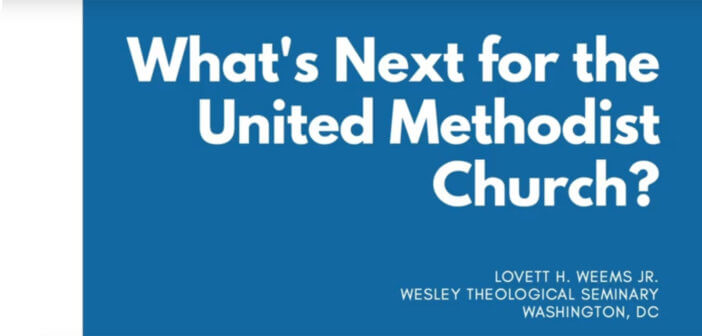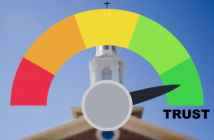Lovett Weems succinctly reviews how the United Methodist Church got to its current dilemma regarding human sexuality, the situation after the Special General Conference, and options for the future.
Download this video free from Vimeo.
- Transcript
-
What’s Next for the United Methodist Church
Lovett H. Weems, Jr.Let’s begin with a shorthand version of how the United Methodist Church got to its current dilemma about human sexuality before exploring options for the future.
The first public debate on homosexuality came at the 1972 General Conference. There was a proposal to include in the Social Principles these words: “Homosexuals no less than heterosexuals are persons of sacred worth….” The General Conference added these additional words: “though we do not condone the practice of homosexuality and consider this practice incompatible with Christian teaching.”
Subsequent General Conference actions included:
- Not recognizing same sex marriage in 1976 saying: “We do not recognize a relationship between two persons of the same sex as constituting marriage.”
- Also in 1976, there was a ban on the use of church funds “to promote the acceptance of homosexuality.”
- In 1984, ordination was addressed, saying: “. . . self-avowed practicing homosexuals are not to be accepted as candidates, ordained as ministers, or appointed to serve in the UMC.”
- In 1996, clergy were forbidden to celebrate homosexual unions, nor could the ceremonies be held in United Methodist churches.
Then in 2016, the General Conference asked the Council of Bishops to appoint a commission to bring a proposal to a special General Conference to be held in February 2019. The Commission on a Way Forward did their work and brought to the Special Session three plans.
In addition to the One Church Plan supported by most of the bishops, there were two other proposals submitted, the Connectional Conference Plan and the Traditional Plan.
The One Church Plan recognized diverse theological and scriptural understandings, removed negative and restrictive language about homosexuality, and required no annual conference, bishop, congregation, or pastor to act contrary to their convictions.
The Connectional Conference Plan created three values-based Connectional Conferences: Traditional, Unity, and Progressive, with each having its own Book of Discipline. Conferences and churches decide which Connectional Conference to join.
The Traditional Plan strengthened current language of the Discipline concerning human sexuality, increased sanctions and punishments, and provided a process for those who cannot live within the Discipline to leave.
There was also a fourth plan on which the General Conference voted. The Simple Plan removed all negative or restrictive language regarding homosexuality as the policy for everyone.
So, what happened at the 2019 Special General Conference?
The Traditional Plan passed 438 to 384, a 53 percent majority. Persons on both sides of the debate seem to agree that among the delegates from the United States, approximately two-thirds favored the One Church Plan instead of the Traditional Plan. However, there were enough votes for the Traditional Plan among Central Conferences outside the U.S., along with their U.S. votes, to defeat the One Church Plan and pass the Traditional Plan. Remember it was the Traditional Plan that keeps the current church positions on homosexuality with additional sanctions and punishments for violations.
Responses to the Special Session Action
Let’s look now at approaches people are advocating given the 2019 vote.
Five broad approaches revolve around governance issues, strengthening current positions, rejection and resistance, a church division with one side leaving, and dissolution.
Governance Issues. Some believe that, quite apart from homosexuality, important governance issues have come to light through this debate. One set of reforms would give the U.S. standing that permits it to shape policies that fit in our context, even as Central Conferences outside the U.S. now can do.
Then there is the larger debate over the role of General Conference in relationship to Annual Conferences. Annual Conferences are older than the General Conference. There were 12 Annual Conference sessions before the Christmas Conference met. Then Annual Conferences continued to meet until the Annual Conferences created the General Conference in 1792.
In Methodism, the Annual Conference is “the basic body of the church.” For example, the Annual Conference is the only body that decides who is ordained. This right has never been delegated to bishops, seminaries, or the General Conference. However, many see the General Conference assuming more power over issues belonging to the Annual Conferences. Some advocate a far more circumscribed role for the General Conference with more decisions left to Annual Conferences and local churches.
Support. A second type of response is to support the General Conference actions and take them further through strengthening current restrictions and adding more punishments. Some plan to modify and resubmit a series of measures previously ruled unconstitutional, even as they monitor compliance with current sanctions.
Rejection and resistance. A third approach is to reject, resist, and advocate for change. This has been the most common route used when a General Conference action lacks enough credibility within the church to be accepted without further debate.
Here are a few historical examples of clergy, laity, bishops, and annual conferences rejecting through their action legislation passed by the General Conference.
- Clergy between 1884 and 1928 who performed a marriage for a divorced person with a living former spouse, except for the innocent party in a divorce caused by adultery;
- Clergy between 1880 and 1968 who smoked;
- The Kansas, Minnesota, New England, Pittsburgh, and Rock River Annual Conferences in 1888 when they elected women to General Conference
- Churches in the 1960s that refused admittance to African American worshipers
- And today clergy who practice rebaptism
- As well as churches that refuse to receive a clergywoman or a pastor of another race.
All these actions were or are forbidden by the Discipline at the time.
On Group Leaves. A fourth response to controversial actions has been for the church to divide with one side leaving to form a new church. Such divisions have occurred in our history. Race and slavery were the reason for most divisions. Other reasons involved holiness (multiple times) and centralized episcopal authority, lay representation, free pews, and concern for the poor.
It is interest to note other divisive issues over which the church did not divide including the creation of the segregated Central Jurisdiction and its dissolution, not ordaining women and ordaining women, admitting women as lay delegates, divorce, smoking, drinking, death penalty, abortion, and the Vietnam War.
Dissolution. A fifth and new course some advocate is a dissolution of the United Methodist Church and then everyone chooses from two or three new denominations. This is the most complex, confusing, and convoluted of the options. If even possible, it would take years to accomplish and probably countless legal obstacles. However, this option appears to be supported by those most anxious to separate from those with whom they disagree based partly on the assumption that this vehicle gives them a better chance of garnering more churches to their cause than merely leaving themselves and inviting other churches to follow.
What’s Next for the United Methodist Church?
I’ve been reading lately about three things: 1) Methodism’s history with slavery and race, 2) the breakup of the church between north and south in 1844, and 3) the quarter century of proceedings leading to north and south reuniting in 1939.
I’ve been struck by the absence of serious biblical, theological, and historical engagement with the issues at stake. I fear the same today. Notice how seldom you hear the words of Jesus and John Wesley quoted.
Another observation is that when the wisdom of God on an issue was manifestly not apparent to everyone, the default mode was not to give more time to discern God’s will but rather to turn to their social and political preferences as if it were God’s will.
Here’s something I came across reading about my home conference of Mississippi as the church was splitting between north and south. Here’s how a pastor described the division. Remember he supported the position of the south and felt the division was inevitable.
The whole Church was convulsed from center to circumference. The mind of the Church was filled with this unprecedented disaster. To this writer it was the darkest day he had ever seen.
This . . . ruinous convulsion exploded in the General Conference in May and June. . . . and the entire portion of the year usually devoted to . . . efforts to save souls was taken up with this humiliating and much-to-be-deplored disaster to our glorious Church. … It is a fearful thing to rend the body of Christ….
Sometimes people ask if any group has dealt with these issues successfully. Yes, there is. I find virtually all United Methodist congregations have found a way to deal with differing opinions without splitting or hindering the Lord’s work. I have not met a church member yet who wants another member of their church who disagrees with them put out of the church. And few church members, if any, are interested in telling another church what they can or can’t do.
At the General Conference level, the debate is driven by the 10 to 15 percent on either extreme who can hardly bear being in a church where people disagree with them at this moment about homosexuality. Sure, others vote with them because they share their stance on homosexuality, but the crucial difference is that the 70 percent may differ on homosexuality but none of them wants to push anyone out of the church and certainly don’t want their church dissolved. The largest group in almost all Annual Conferences today is either Traditionalists for One Church or Progressives for One Church.
I recently asked clergy and laity attending an annual conference if their current church was established prior to their birth. Virtually all were. That’s a good reminder that we and our current opinions are not the center of the universe. Most of what is United Methodism was achieved long before any of us arrived on the scene. We dare not trifle with this pearl of great price as if it belongs to us alone.
We desperately need to find a way to honor conscience and still live together until that day – and I am confident it will come – when God’s wisdom for the future is more clearly revealed.
If some cannot abide this diversity. Departure is an honorable decision but bringing chaos to thousands of churches who don’t share such certainty and impatience is not. None of us should try to take a denomination or annual conferences with us. They are not ours to take.
Our unity has never been and can never be based on anything but Jesus Christ. In Christ we trust that in due season we shall see more fully what is now seen only dimly.
Lovett H. Weems, Jr., is distinguished professor of church leadership emeritus and senior consultant of the Lewis Center for Church Leadership at Wesley Theological Seminary in Washington, DC. His books on United Methodist issues include Focus: The Real Challenges That Face the United Methodist Church (2012), Leadership in the Wesleyan Spirit (1999), and John Wesley’s Message Today (1991), all published by Abingdon Press.
We invite you to subscribe to Leading Ideas — our online newsletter with information, resources, and strategies for forward-thinking church leaders — at https://www.churchleadership.com/leadingideas.




